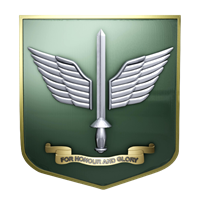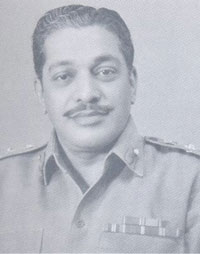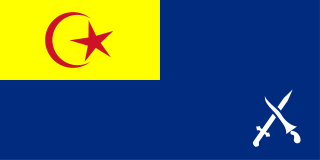
The Singapore Army is the land service branch of the Singapore Armed Forces (SAF). The largest of the four branches of the SAF, the Singapore Army traces its origins to the 1st Battalion, Singapore Infantry Regiment, which was formed in 1957, when Singapore was still under British colonial rule. After Singapore's independence on 9 August 1965, the Singapore Army Bill was passed in Parliament on 23 December 1965, and National Service (NS) was subsequently introduced in 1967. Mostly made up of conscripts, the Singapore Army can mobilise all operationally-ready military reservists in the event of war or national exigencies.
Commandant is a title often given to the officer in charge of a military training establishment or academy. This usage is common in English-speaking nations. In some countries it may be a military or police rank. It is also often used to refer to the commander of a military prison or prison camp.

Commandos is the special forces formation of the Singapore Army responsible for conducting special operations. Commandos are tasked with infiltrating behind enemy lines by raiding and reconnaissance operations using airborne raids, helicopter assault and sea landings. The formation is made up of only one battalion, the 1st Commando Battalion, and is based in Hendon Camp.

The Royal Ranger Regiment is an infantry regiment of the Malaysian Army. Although it is second in seniority to the Royal Malay Regiment, the RRD can trace its origins back to the mid 19th century and the establishment of The Sarawak Rangers, the peacekeeping force in the Sarawak region. This force was absorbed by the Sarawak Constabulary in 1932, but the name was revived in 1941 as a British Colonial unit; this unit commanded by British Lieutenant Colonel C.M. Lane was captured by the Japanese in 1942.
Tunku Tan Sri Osman was the first Malaysian Armed Forces Chief of Staff. He was a nephew of Tunku Abdul Rahman, Malaysia's first Prime Minister as well as a cousin of Sultan Abdul Halim, Tunku Abdul Malik, Tunku Annuar and Sultan Sallehuddin since their fathers and Tunku Abdul Rahman were brothers. General Tunku Osman was known for his strong principles and self-discipline as well as highly respected by the ranks and files of the army.

Gerak Khas (GK), or Grup Gerak Khas, (GGK) also spelled Gerakhas, is a Malaysian Army special forces (MASF) unit that performs special operations missions such as direct action, unconventional warfare, sabotage, counter-terrorism, and intelligence gathering. Gerak Khas was founded in 1965 during the Indonesia-Malaysia conflict, and they gained worldwide fame and recognition after successfully pacifying the communist insurgency in Malaysia's jungles between 1968 and 1989.
Singapore has had an history of armed conflict and personnel dating to the colonial period.

The maroon beret in a military configuration has been an international symbol of airborne forces since the Second World War. It was first officially introduced by the British Army in 1942, at the direction of Major-General Frederick "Boy" Browning, commander of the British 1st Airborne Division. It was first worn by the Parachute Regiment in action in North Africa during November 1942.

The Ghana Army is the principal land warfare force of Ghana. In 1959, two years after the Gold Coast became independent from the British Empire, the Gold Coast Regiment was withdrawn from the Royal West African Frontier Force and formed the basis for the new Ghanaian army. Together with the Ghana Air Force and Ghana Navy, the Ghana Army makes up the Ghana Armed Forces, which is controlled by the Ghanaian Ministry of Defence and Central Defence Headquarters, both of which are located in the Greater Accra Region.
The red beret is a military beret worn by many military police, paramilitary, commando, and police forces and should not be confused with the maroon beret worn by airborne troops all around the world.

General Deshamanya Don Sepala Attygalle, was a Sri Lankan army officer, civil servant and diplomat. The longest serving Commander of the Sri Lankan Army (1967–1977), he went on to serve as the Permanent secretary to the Ministry of Defence and Sri Lankan High Commissioner to the United Kingdom.
Colonel Aslam Fazly Laphir, PWV, RWP, RSP, SF was a Sri Lankan Army officer and posthumous recipient of the Parama Weera Vibhushanaya (PWV). He was awarded the PWV for his actions leading the 1st Special Forces Regiment during the Battle of Mullaitivu in which he was killed. Colonel Laphir played a major role in the formation and development of the Special Forces Regiment from the original Combat Tracker Team.

General Tissa Indraka Weeratunga, VSV was a Sri Lankan general. He was the Commander of the Sri Lankan Army from 1981 to 1985 and the first General Officer Commanding (GOC) of the Joint Operations Headquarters (JOH), he was later Sri Lanka's High Commissioner to Canada from 1986 till 1990.
Winston Choo Wee Leong is a former Singaporean diplomat and lieutenant-general who served as Director, General Staff between 1974 and 1976, and then Chief of the General Staff between 1976 and 1990, and later Chief of Defence Force between 1990 and 1992. He was the longest-serving head of the Singapore Armed Forces (SAF).

The Royal Johor Military Force is an independent military force of the state of Johor and the private royal guard of Sultan of Johor in Malaysia. The JMF is Malaysia's oldest active military unit still in operation and the only military in the Federation that is maintained by a state. The force comes under the control of the Sultan. Its headquarters are located at Sultan Ibrahim Camp, Johor Bahru.
General Shantha H.S. Kottegoda, WWV, RWP, RSP, VSV, USP is a retired senior Sri Lanka Army officer. He was the seventeenth commander of the Sri Lankan Army from 1 July 2004 – 5 December 2005. He had served as the Sri Lankan Ambassador to Brazil and Thailand. In April 2019, following the Easter Sunday bombings he was appointed as the permanent secretary to the Ministry of Defence.
Brigadier Tuan Samayraan Buhary Sally was a Sri Lanka Army officer, who served as the Chief of Staff of the Sri Lanka Army and was the first Malay and Muslim in the country to reach this rank and post.

Sulaiman bin Haji Damit was a Bruneian aristocrat, diplomat and military officer who served as the commander of the Royal Brunei Armed Forces (RBAF) from 1990 until 1994. He and Ariffin Abdul Wahab were the first local servicemen to be promoted to the rank of lieutenant colonel in 1976.
The SAF Day Parade is an annual military parade and ceremony of the Singapore Armed Forces (SAF) held on 1 July in commemoration of the founding of the SAF. It is the second military parade in seniority to be held in Singapore next to the Singapore National Day Parade on 9 August. It is usually held at the SAFTI Military Institute in Jurong West, with the presence of the president of Singapore. Salutes are also taken by the prime minister of Singapore, and the chief of Defence Force.
Brigadier Edirimuni Tennison De Zoysa Abeysekara was a Sri Lankan military leader, who served as the Chief of Staff of the Sri Lanka Army.









